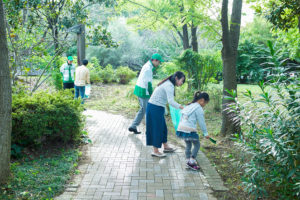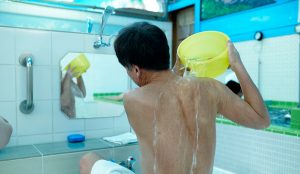Everyone Around the Nabe Pot
Nabe Manners Decided by Seating
When thinking about winter fun, having nabe (Japanese hotpot) with family and friends comes to mind. Although there are many types of nabe, chanko nabe that sumo wrestlers eat is what comes to people’s mind when thinking of nabe the most. Taking influence from old Mihogaseki Stable, nabe restaurant ‘Chanko Masuiyama’ owner Hideki Sawada says, “Nabe is the type of food that when people eat together, their manners change”. When with friends, you can portion out the food with ease. In a work setting, the younger person sitting at a lower seat of the table naturally has the role to portion out the food. In a sumo stable, the youngest members portion out the food and hand it to their seniors. Sawada mentions, “it’s said that when there is only the soup left for the young sumo wrestlers, they put lots of rice in it, to cultivate a hungry mentality.” All there is to worry about now is to be careful to not take food directly from the nabe pot with your own chopsticks, and merely happily eat your food.

Nabe’s Origins from the Birth of Earthenware Pottery
Nabe started at the same time as earthenware pottery. Taking a traditional charcoal grill into a tatami room and eating around the nabe pot started in the latter half of the Edo Period. There are theories that chanko nabe was either devised by famous Yokozuna sumo wrestler from the Meiji Period, Hitachiyama Taniemon, or by a sumo wrestler saw a wok being used for cooking when on tour in Nagasaki and came up with the idea. In the sumo world, there are many superstitions and one of them is that “all fours means losing”, and therefore ingredients for nabe like beef or pork were avoided, and instead chicken, fish and vegetables were used. For the broth, ingredients like kombu seaweed, bonito (a fish) and chicken bones were set in each individual sumo stable. “It is said that to increase the feelings of togetherness felt by sumo wrestlers, they ate around one nabe pot,” Sawada continues. “Therefore to eat happily can be seen as a part of good manners.”

Eating Everything Before Putting the Rice in
The fun finish to eating nabe is putting something like rice or udon in the left over broth. Before doing so, everything in the nabe should be eaten up, and having a clean soup is another trick to happily eating. Well know in the gourmet world, epicure Rosanji Kitaoji in his essay “Talking about Nabe”, explains that the first ingredients put into the nabe should add to the broth, the next ingredients should absorb the broth, and the nabe should be organised every time each ingredient is added. After all the ingredients that contributed to the broth are taken out of the nabe, the rice is put in. Once it has almost boiled and the rice has absorbed the broth, a beaten egg can be added, and then it is ready to be eaten. Everyone with smiles on their faces, it is a time of good manners on a fun winter’s day.

Data
| When did this start? | Alongside the discovery of earthenware pottery in the Jomon Period. |
| Where can we try this? | In homes across Japan. Chanko nabe in the Ryogoku area of Tokyo. |
| Best suited time of the year or day? | From when it gets cold in fall to winter |
| Data (as of October 2016) | Amount of nabe eaten: 7.92 times/month (2016) Cost of nabe: 736 yen (at home), 2,501 yen (eating out) (Kibun, Nabe White Paper 2016) |
| Please Note | Manners matter, even with friends. From a sanitary perspective as well, it’s best to not use your own chopsticks when taking from the nabe pot itself. |
Reference:
Kibun, Nabe White Papers
“Rosanjin’s Dining Table” (Rosanjin no shokutaku) Rosanjin Kitaoji (Kadokawa Haruki Corporation)
“88 mysteries about Japanese food and Japanese.”
(Dareka ni hanashitakunaru! Washoku to Nihonjin Omoshiro zatsugaku)
Kaitaro Takeda (Daiwa Shobo)
Photos in cooperation with:
Chanko Masuiyama (3-2-12 Chitose, Sumida-ku, Tokyo) TEL: 03-3631-0109





